The great thing about football is there are a million different ways to play it. It's the job of the manager to mould the way a team plays, and you only have to take one look at the Elite end of the sport to see differences in the way team’s set-up and play football.
There are many formations and tactics being employed be various teams, with hundreds of subtle distinctions branching off from them. Here, we give a coach's guide to the most common, what you'll need to make a success of it, and an example of a team you could study to get it's best version.
Classic 4-4-2
This is one of the oldest formations in football. Despite going out of fashion in recent years, 4-4-2 has enjoyed somewhat of a resurgence, mainly thanks to Leicester City in the Premier League and Atletico Madrid in La Liga.
The key to 4-4-2 is partnerships. The two strikers, midfield pairing and full-back and wingers each need to have to have a telepathic understanding of their role on the pitch.
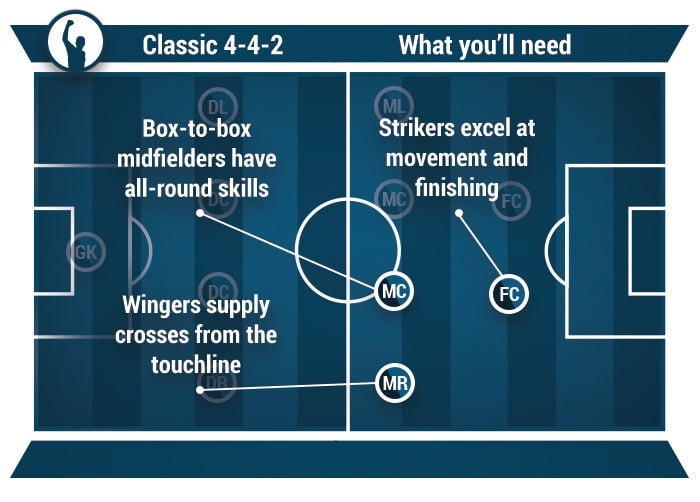 The wide midfielders are often skilful, with pace to burn and a deadly accurate cross. To help them, full-backs look to overlap to provide an extra attacking option. What it results in is plenty of service for your two strikers, who should always be lurking in the box sniffing out a chance at goal. Often, these strikers compliment each other by having a different set of skills – for example a tall striker who is good in the air and a smaller, more agile forward who can feed off any knocked down balls.
The wide midfielders are often skilful, with pace to burn and a deadly accurate cross. To help them, full-backs look to overlap to provide an extra attacking option. What it results in is plenty of service for your two strikers, who should always be lurking in the box sniffing out a chance at goal. Often, these strikers compliment each other by having a different set of skills – for example a tall striker who is good in the air and a smaller, more agile forward who can feed off any knocked down balls.
The weakness of the 4-4-2 formation is the rigidity and amount of work expected of the two central midfield players. In modern football, it's more fashionable to have at least three players operating in and around the centre of the pitch, leaving a two-man central midfield short of bodies.
When playing 4-4-2 then, it's imperative you select tireless central midfielders who are comfortable when both creating and defending.
A fine example of Classic 4-4-2 is the treble winning Manchester United side of the late 90s. They had all the ingredients required: two of the best wingers in a business, a strike partnership that knew where the back of the net was, and two busy central midfielders who could attack and defend.
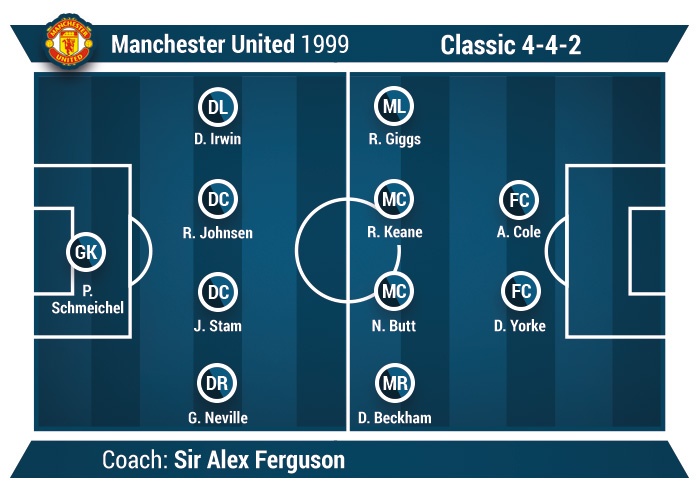
Tiki-Taka
Anyone who has watched European football over the past ten years will have witnessed the rise of Tiki-Taka football. Both Barcelona and Spain have adopted this style, with great results, winning league titles, European cup’s and international tournaments.
Defined by short, intricate passing and fluid movement between every player on the field, the key to its success is overloading the midfield area with technically skilful players who can retain possession of the football for large periods of the game; adding intelligent, nimble attackers who are able to create space and drag the opposition out of position.
A popular footballing idiom says that “if the opposition haven't got the ball, they can't score”. Tiki-Taka draws on this by hoarding the ball for 60-70% of the game and controlling the pace of play.
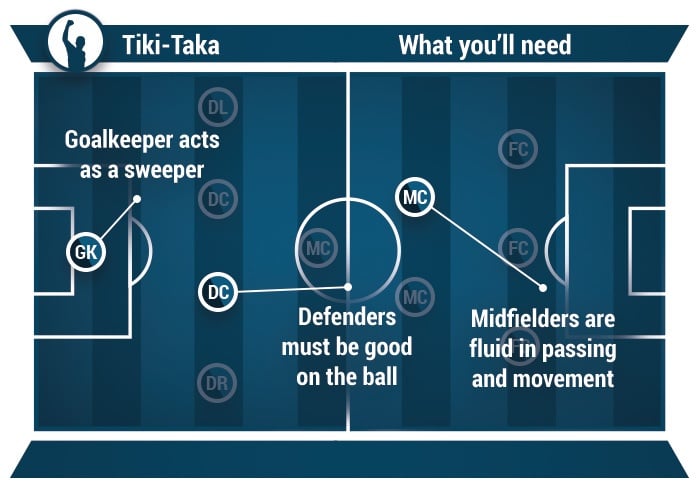 It’s difficult to place a formation on this system of play, as fluidity is key to the way it works. But having one holding midfield player was a must. This gives the other two, more creative midfield players license to roam and concentrate on providing goal-scoring chances.
It’s difficult to place a formation on this system of play, as fluidity is key to the way it works. But having one holding midfield player was a must. This gives the other two, more creative midfield players license to roam and concentrate on providing goal-scoring chances.
The space for these midfielders to work in is increased by the continued presence of the full-backs going forward and joining in the attacking play. At Euro 2008, Sergio Ramos and Juan Capdevilla both got forward and disturbed the shape of the opposition midfield whilst providing an outlet for midfield players in possession.
Tiki-Taka football has seen a decline in recent years, especially as opposition teams have found success in pressing the team in possession or hitting them on the counter-attack.
Today, the most common response to a Tiki-Taka team is to sit back and allow the opposition to play in front of you, remaining as compact as possible to sniff out any danger in final third. When the ball is then retrieved, teams can be found lacking numbers in defence as this system requires teams to maintain a line line up the pitch.
As a result of those weaknesses being exposed, Tiki-Taka has become more direct. Still, the style has revolutionised the game as we know it, making it a much more aesthetically pleasing sport.
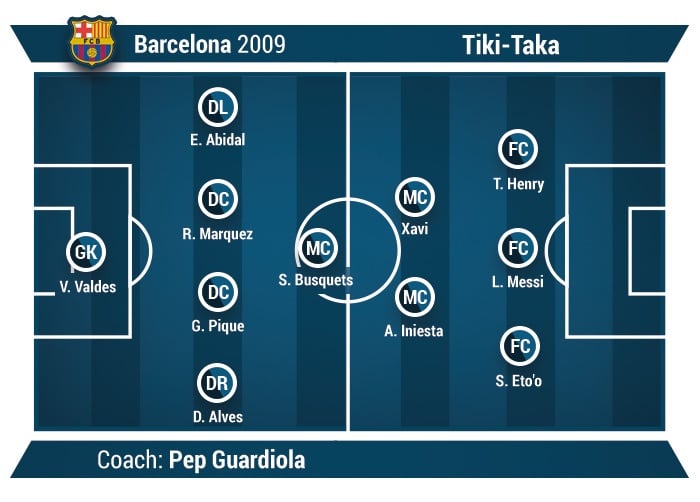
The Counter-attack
Whilst Tiki-Taka has declined in recent years, it's place has been taken by the most devastating tactic of them all – the counter-attack. Drawing the opposition into your defensive third, a counter-attack starts when you steal the ball and launch into an attack at break-neck speed.
Essentially, the tactic involves dropping deep, allowing the opposition to have the ball and come forward with it, committing players forward and leaving gaps in behind as they go. The aim is to take the ball off the opposition, exploiting the space left to attack and score.
 Counter-attacking sides are often split into two units – defend and attack. The defensive unit sits deep and tight, pouncing on any loose ball to regain possession. At this point, they ping the ball forward to their attacking unit. These players are often fast and skilful, allowing them to sprint into space and create 1-on-1 situations with defenders.
Counter-attacking sides are often split into two units – defend and attack. The defensive unit sits deep and tight, pouncing on any loose ball to regain possession. At this point, they ping the ball forward to their attacking unit. These players are often fast and skilful, allowing them to sprint into space and create 1-on-1 situations with defenders.
The key to the counter-attack is a getting the ball forward at pace. Bank on your best 3-attackers being better than their best 4-defenders. Get the ball to them before the opposition can reset themselves, and use the available space.
Be the best coach you can be in 2017 - Free Ebook
Crammed full of coaching advice on everything from motivating your team to preperation, Pitchero's Sports Coach Bible '17 Ebook can help you improve your coaching skills and own it out on the training pitch this weekend.
Without any of the required ingredients, the counter-attack is quite a risky system to play; especially from the start of a match, as the opposition are essentially invited to attack. It's also a great tactic to adopt when in the lead. The opposition will be pouring players forward in an attempt to find an equaliser, thus leaving plenty of space for a counter-attack to develop.
Great examples of counter-attacking teams are the 2015/16 Premier League title winning team of Leicester City, or Real Madrid's Champions League winning side in 2014. Madrid, armed with the likes of Gareth Bale and Cristinao Ronaldo in attack and outstanding deep-lying playmakers in Xabi Alonso and Luka Modric, used the counter to annihilate proponents of Tiki-Taka Bayern Munich 4-0 on their way to European glory.
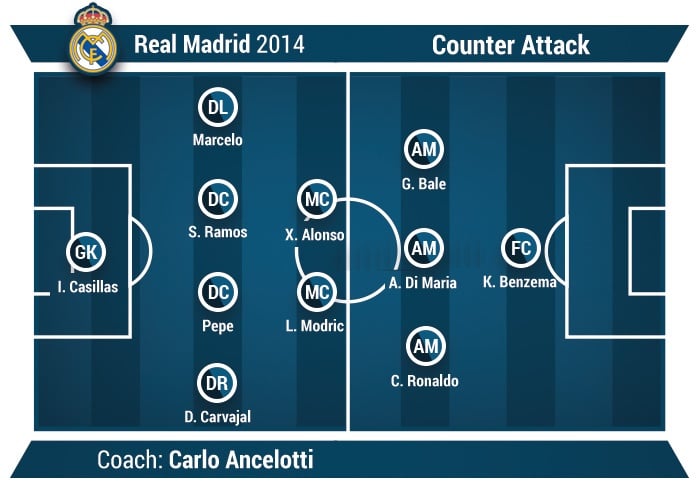
Park the Bus
This is a phrase which has been made famous by Jose Mourinho, following a game between Chelsea and Tottenham Hotspur at Stamford Bridge. The game finished 0-0, which in Mourinho’s eyes was due to the negative tactics of Tottenham.
The tactic of parking the bus is essentially to take to the field with the sole purpose of not conceding a goal. Attacking football is very much a secondary thought when parking the bus; it's all about frustrating the opposition and keeping a clean sheet. If the match ends 0-0, then so be it.
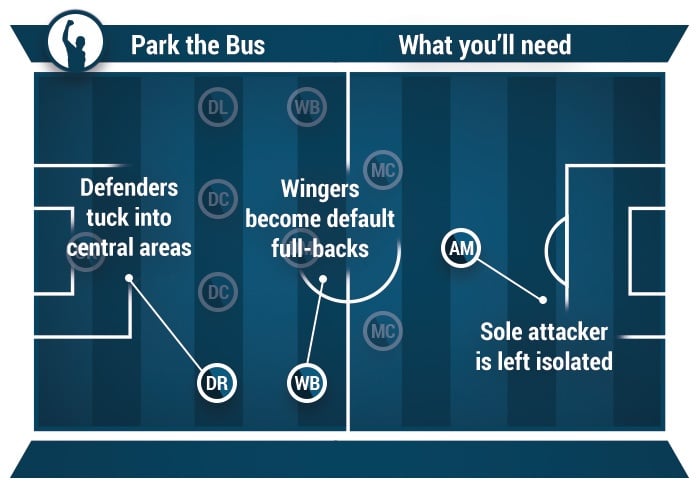 The 4-5-1 formation is common when teams are parking the bus, as it provides two defensive rows of 4 and 4 players, with one man further forward who can close down the opposition when they have the ball in deeper positions. Often, when teams hone in on the opposition goal, this formation takes on more of a 6-4, with wingers tucking in as full-backs and the striker becoming an extra body in midfield.
The 4-5-1 formation is common when teams are parking the bus, as it provides two defensive rows of 4 and 4 players, with one man further forward who can close down the opposition when they have the ball in deeper positions. Often, when teams hone in on the opposition goal, this formation takes on more of a 6-4, with wingers tucking in as full-backs and the striker becoming an extra body in midfield.
The defensive nature of the tactic lead to it's name, alluding to building a impenetrable wall in front of your goal. To make a success of it, you need a disciplined team full of players who are willing to fight for every ball. Whilst it can lead to shutting the opposition's offensive options down, you won't find yourself winning many games with this tactic as you won't be committing any players to attack.
Rightly or wrongly, coach Tony Pulis has often been tagged with a proponent of parking the bus. As manager of Stoke City between 2008-2013, they were famous for defensive football and would often play for a point in away matches in the Premier League.
In general however, it remains a tactic teams will adopt in individual games rather than over an entire season – particularly if you're up against a team you feel are of superior attacking ability. One example comes from Mourinho himself, who played no recognised striker in a Chelsea game Vs Manchester United at Old Trafford in 2013.
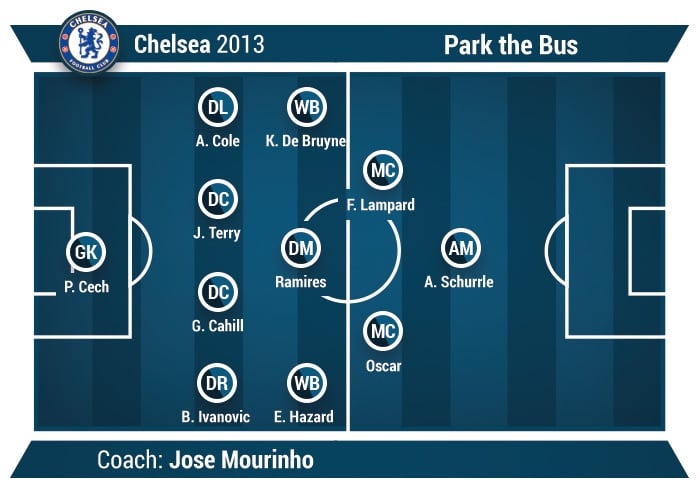
Who is Pitchero?
We're the number one online solution for sports clubs. Visit our club website today to see why thousands of clubs trust Pitchero to help them grow and manage their sports club.
The Long Ball Game
This is a tactic which is often sneered at. Not particularly pleasing on the eye and requiring less of the more respected technical skills required, defensive-minded teams are often the ones who adopt a long ball strategy.
In essence, the idea of playing the long ball game is to send the ball forward from deep positions in the air towards a striker who takes the ball down and begins an attack.
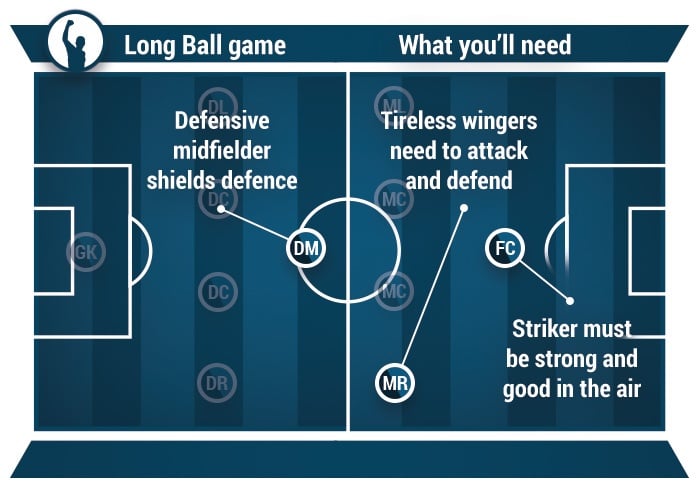 To play this tactic successfully, the forward players need to be strong, capable of holding up the ball and good in the air. The long ball can also be used to play the ball into space for a fast attacking player to latch on to. You'll also need a couple of outstanding attacking midfielders who have the ability to join the attack and ensure the striker doesn't become isolated.
To play this tactic successfully, the forward players need to be strong, capable of holding up the ball and good in the air. The long ball can also be used to play the ball into space for a fast attacking player to latch on to. You'll also need a couple of outstanding attacking midfielders who have the ability to join the attack and ensure the striker doesn't become isolated.
Long ball teams are often defensively minded in their approach. Their intention is get the ball as far away from their goal as possible, using physical players up top to dominate the opposition in the air.
Long ball football is often criticised as being ugly but it can produce moments of brilliance. Dennis Bergkamp’s goal for Holland against Argentina is replayed time and time again, as being one of the best in the 1998 World Cup. he goal was started by a long ball, sent by defender Frank de Boer over seven Argentine players, who were instantly cut out of the game. Bergkamp's technical ability was rightly praised - but it still needed a good old-fashioned hoof upfield to get the move going.
Sam Allardyce is perhaps English football's most well-known fan of a long-ball strategy. Using arguably the game's most physical front man, Kevin Davies, and a midfielder who knew where the back of the net was in Kevin Nolan, Allardyce oversaw a successful Bolton Wanderers team from 1999-2207.
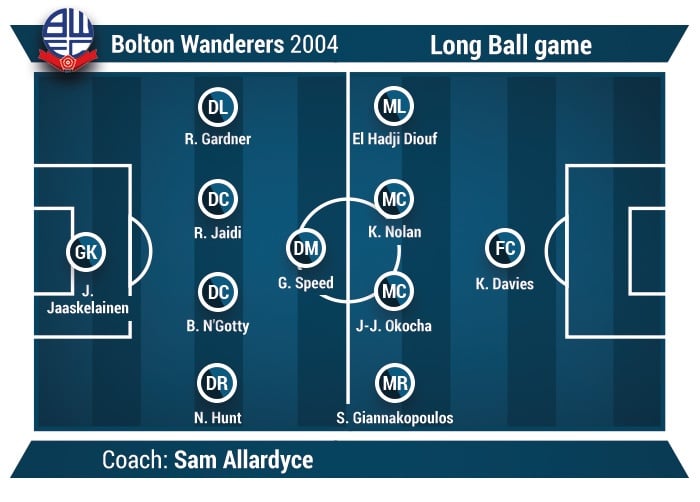
The High Press
In contrast to a number of the tactics discussed above, the high pressing game is one that is built from how you play off the ball, rather than on it. At it's core, the high press works on the precedent that the higher up the pitch you win the ball, the short distance you have to go to get into a goal scoring position.
What results is a team that play an incredibly high line, with all ten outfield players harrying and hustling the opposition when in possession. Teams who adopt other tactics will often let the opposition hold possession in their own half, safe in the knowledge they can do little harm so far from goal. What makes the high press stand out is that this harassing of the opposition occurs no matter where the ball is.
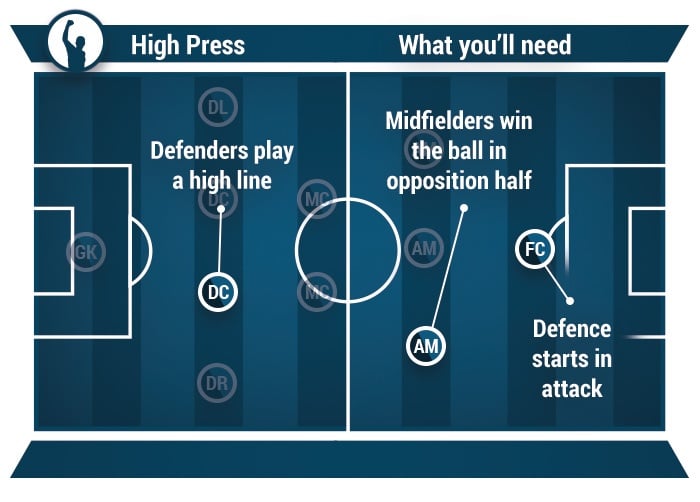 This tactic can work well against teams who like to maintain possession. Pressing the opposition puts incredible pressure on each and every pass the opposition make. One slip up, and suddenly you're in an advanced position with a number of your attacking players already up the pitch.
This tactic can work well against teams who like to maintain possession. Pressing the opposition puts incredible pressure on each and every pass the opposition make. One slip up, and suddenly you're in an advanced position with a number of your attacking players already up the pitch.
For it to work then, you need ten outfield players who press as an entire unit. It can be one of the most tiring tactics to implement for players, as they are required to get in the faces of the opposition for a full 90-minutes, but it's rewards can be huge. Defending starts at the very top of the pitch, so select a striker who is unselfish, mobile, and doesn't mind getting involved in the physical side of the game.
Instinctively, long-ball teams can succeed against pressing teams. Lifting long balls over the defensive line, fast players who are willing to run the channels can suddenly cut your entire press out of the game, exposing the space in-behind your team.
For a perfect exponent of the press, watch Jugen Klopp's Liverpool team of today. For Klopp, it began with a very successful stint as Borussia Dortmund coach, where his high pressing game took the team to the Champions League final in 2012.

Be the best coach you can be in 2017 - Free Ebook
Crammed full of coaching advice on everything from motivating your team to preperation, Pitchero's Sports Coach Bible '17 Ebook can help you improve your coaching skills and own it out on the training pitch this weekend.

